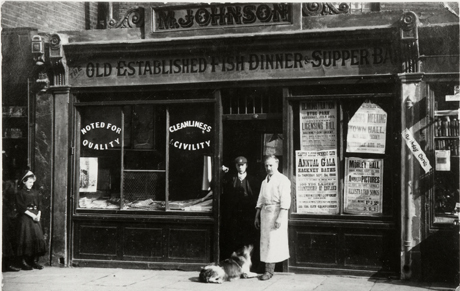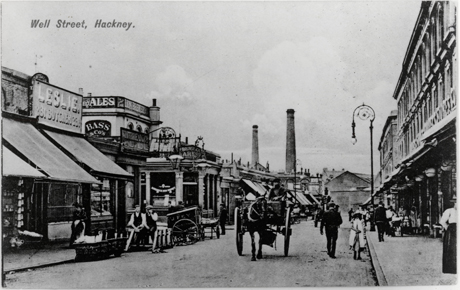Walk down a Well-trodden street

Well Street 1908, south side No 164. Premises of M. Johnson, fishmonger. Photograph: Hackney Archives
If you were searching for the elusive ‘real East End’, Well Street wouldn’t be a bad place to start. Winding its way from the lower end of Mare Street north-west to the junction of Kenton and Wick roads, Well Street has for centuries been a place to buy things.
The road originated as a lane connecting Mare Street to Homerton, and it has been settled at least since the mid 15th century, when the common still bearing its name (but no longer connected to it) was called ‘Well Street Field’. At this time the street was well-to-do – there was a moated Pilgrim’s House on the north side of the street at the western end and a similar structure on the south side.
Residential development in Well Street started in earnest in the early 19th century. An estimated 200 households lived there in 1821, including working class and ‘genteel’ families. In the mid 19th century, the Crown acquired land for the construction of Victoria Park, which opened in 1845, providing a further stimulus to residential building in the area north of the park.

Well Street c1905. View north east from Cresset Road to Berger's Paint Factory. Photograph: Hackney Archives
Nineteenth-century Well Street was a relatively prosperous place known for its shops, which served the residential patch adjoining Victoria Park. There was also a smattering of light industry, included rope-making, boot-making and leather-working. In 1913 the street acquired a cinema, the South Hackney Picture Palace.
In the 1920s, the western portion of Well Street was widened and two new estates were built in the vicinity by London County Council – Shore Estate, finished in 1930, and Kingshold Estate, opened in 1932. Following bomb damage during the Second World War, Frampton Park and Gasgoyne estates were constructed nearby.
Down the centuries, Well Street has been shaped by a number of important figures. The initial development of the area in the 17th, 18th and 19th centuries was heavily influenced by the trustees of the charitable Sir John Cass Foundation. Sir John Cass (1661-1718) was a local politician, businessman and philanthropist who built housing and schools for the poor.
His family moved from the City to Grove Street (now Church Crescent) Hackney in 1665 to escape the plague. Cass (after which nearby Cassland Road is named) made his money as a builder and merchant. In the early 18th century, he served for a term as a Conservative MP for the City and founded a school in the churchyard of St Botolphs Aldgate in 1709.
The Sir John Cass Foundation, established in 1748 and active to this day, established a range of educational institutions, the best known of which is perhaps the Sir John Cass School of Art. The foundation has also provided funding for Sir John Cass Hall, a student residence at 150 Well Street.
Celia Fiennes is another resident of Well Street to have gained a place in history. The 18th century diarist and traveller spent most of her time roaming Britain, but eventually moved to the Well Street area in 1738 and died there in 1741. Though not published until well after her death, Fiennes’s diaries provide a fascinating insight into the changing landscape of a country entering the industrial age. A building bearing her name was erected at the corner of Well Street and Mare Street in the late 20th century.
Also an influential local figure is Jack Cohen, founder of the Tesco supermarket chain. Well Street has had an active market since the 1850s and it was this that attracted the young entrepreneur. Cohen fought in the First World War, and following the Armistice, he spent his de-mob money on surplus NAAFI goods which he decided to try to sell at local markets.
The first market he chose was Well Street, where legend has it he made a £1 profit on his first day. Cohen’s business grew, and Tesco was formed – ‘Tes’ for merchant TE Stockwell who supplied the young trader with tea, and ‘Co’ from his own name. The supermarket giant, now the third-largest retailer in the world, has in recent years has an arguably less beneficial effect on the street, as its nearby outlets have been credited with stifling local business.
The market lives on, however. The Well Street shopping area received a welcome boost when it was officially re-launched in 2011 following the establishment of the Well Street Traders’ and Residents’ Association the previous year. Another recent development has been the arrival of a bevy of artists, who have used space on the street for studios and pop-up exhibitions. The longest-lived of these venues is Karin Janssen’s Project Space Gallery, which graces number 213.
With Hackney’s new Fashion Hub looming to the north in Morning Lane, Well Street faces new challenges and new opportunities. The quaintness of the street is a draw to many – the trick is for the ancient thoroughfare to find a way of preserving both its identity and the shops that have for centuries been its mainstay.
